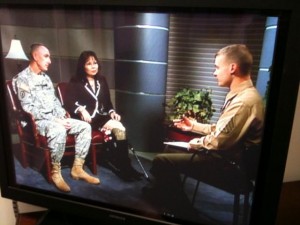
Damariz Escobar, her husband retired SSG Ismael Escobar, and SFC Kathy Shannon hear about federal job opportunities at Fort Belvoir, Virginia.
By Liz Deakin, WTC Stratcom
With more than 250,000 people leaving the military each year, employment is an important aspect of reintegration into civilian society for many transitioning servicemembers. So whether you’re looking for a job at Veterans Affairs (VA)another federal agency, or you need help navigating opportunities in the private sector, below are VA resources to help Soldiers, Veterans, and their Family members obtain career advice and find jobs.
VA for Vets
VA for Vets facilitates the reintegration, retention, and hiring of Veteran employees at the Department of Veterans Affairs (VA). They offer career-search tools for Veterans seeking employment at VA, career development services for existing Veterans, and coaching and reintegration support for military servicemembers. VA for Vets offers real-time, on-demand, round-the-clock support services.
- Career Center – Translate military skills to civilian jobs, take self-assessments, build easy-to-read resumes, apply to open VA positions, and save all results into one profile
- Coaches – Reach out for help with deployment and reintegration issues and questions related to employment at VA
- Professional Development – Take online training to sharpen skills or to learn more about hot topics surrounding deployment and reintegration
- Virtual Collaboration Tool – Interact with a coach, supervisor, or HR professional in a personalized virtual work space
The Veterans Opportunity to Work to Hire Heroes Act 2011
- The Veterans Opportunity to Work (VOW) to Hire Heroes Act of 2011 expands education and training opportunities for Veterans, and provides tax credits for employers who hire Veterans with service-connected disabilities.
- The Veterans Retraining Assistance Program (VRAP) offers up to 12 months of training assistance to unemployed Veterans for education programs that lead to a high demand occupation.
VetSuccess
VetSuccess is an easy to use website providing active duty servicemembers and Veterans with service-connected disabilities the resources, and tools they need to find and maintain suitable employment. 
Resources and tools include:
- Access to multiple job search databases
- Tips for job interviews, job applications, and resume and cover letters
- Resume builder
- Career explorer
- Free online learning
Vocational Rehabilitation and Employment (VR&E) VetSuccess program assists Veterans with service-connected disabilities to prepare for, find, and keep suitable jobs. Servicemembers who received a VA disability rating may begin using this program while on active duty.
VR&E VetSuccess provides a comprehensive range of services, such as:
- Comprehensive rehabilitation evaluation to determine abilities, skills, and interests for employment
- Vocational counseling and rehabilitation planning for employment services
- Employment services such as job-training, job-seeking skills, resume development, and other work readiness assistance
- Assistance finding and keeping a job, including the use of special employer incentives and job accommodations
- On-the-job training, apprenticeships, and non-paid work experiences
- Post-secondary training at a college, vocational, technical, or business school
- Supportive rehabilitation services including case management, counseling, and medical referrals
- Independent living services for Veterans unable to work due to the severity of their disabilities
Education Benefits
The VA provides several educational benefits to help Soldiers progress toward their goals. Two of the most popular are:
- Montgomery G.I. Bill: The Montgomery G.I. Bill is available for those who enlist in the U.S. Armed Forces. Servicemembers who choose to enroll in this program receive up to 36 months of education benefits, which may be used during active duty.
- Post-9/11 G.I. Bill: The Post-9/11 G.I. Bill provides financial support for education and housing to individuals with at least 90 days of aggregate service on or after September 11, 2001, or individuals discharged with a service-connected disability after 30 days. Servicemembers must receive an honorable discharge to be eligible for this benefit.
If you are looking for a job, education benefits, or career training in another field, the VA resources outlined above provide a good place to start. Whether its VA for Vets, Vet Success, or other programs, there is educational and employment help available for all Soldiers and Veterans including the Army’s wounded, ill, and injured.





